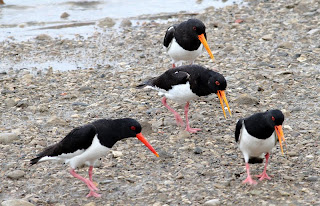Oh, they are not all repeats, maybe similar but certainly “Another Chance To See”.









Bird Watching, Bird Ringing, Photography




































I was pleased I ventured out because I found both flock and gangs of birds, post breeding groups, using the set asides and the margins, feeding on the abundance of insects on a warm, muggy, rain threatening morning. Hirundines were in evidence with a minimum of 70 Swallows and 20 House Martins, and unusually so far away from known colonies, about 20 Sand Martins. At times, as they do at this time of year, in between hawking insects over the crop fields, the flock gathered to rest on fences with a distant Bowland backdrop. I tried to get closer to the birds on the wire but a deep almost overgrown ditch, a trap for the unwary, blocked my progress. Alongside the ditch I found three pairs of Whitethroat “tacking” away, plus 2 Corn Buntings, one in song the other collecting large beakfuls of food and flying away from me over the impassable ditch.


On some weedy margins I found a flock of 60 Goldfinches, with over 20 Linnets, and on a bare field being prepared for late sowing, 6 Skylarks, 5 Pied Wagtails, 5 Mistle Thrush, 3 Blackbirds, 2 Song Thrush, 7 Stock Dove and 8 Wood Pigeon. A Kestrel patrolled over the fields, flushing the finches into the air and attracting the attention of the martins and Swallows that chased after it until the Kestrel made off. I get the feeling that this autumn we will see some huge flocks of Goldfinch, they are now such a successful species in both town and country.


I called in at Hambleton to check out my Swallow population with another single nest to ring, these four with flight feathers very short and recently emerged from sheaths, code “FS” for nest recording purposes. There’s another pair with tiny young that require a visit for ringing in a further week, with two nests containing very large young ringed a week ago, and one pair on eggs. But all in all despite the good weather it seems a below average year for my Swallows. I do wonder what effect the loss of two early nests to predators had on the colony, as the Larsen crow trap remains set but the Jackdaws and Magpies continue to search around for food.


Oh, “The Tandoori”?, you ask of last night. The guy that owns the restaurant was previously the chef at Fayez Tandoori for 17 years so he should know how to make a curry. There was a rather long and daunting menu but once we sussed it out no problem. We enjoyed a really nice meal at a reasonable price. We both tried the chicken with lamb with Maya Rice which with a light touch of lemon and coriander was absolutely superb. The naan bread was so fluffy and lightweight it reminded me of the finger scalding bread straight from the tandoor in the beach shacks of Goa. The takeaway menu is here but I think there may charge be an extra delivery charge for some readers of this blog who live a few miles away.
http://www.eatitnow.co.uk/order/takeaway/poulton-le-fylde/themayatandooribaltihouse-fy67bx/menu
